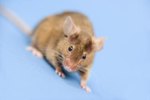
Telling genders apart is practically an impossible task with some animals. Plenty of species feature prominent sexual dimorphism, however, giving much clearer clues regarding the sexes. Male and female raccoons (Procyon lotor), for instance, are extremely similar but they don't look exactly the same.
Gender and Size
Mature raccoons usually weigh somewhere between approximately 4 and 23 pounds. Females are generally on the smaller side of that range, while the males are generally on the bigger side. The boys are usually between 10 percent and 30 percent bigger than the girls. But sizing is definitely not a foolproof method for determining gender. If you have a particularly well-fed female and a scrawny male together during the reproductive season, you could easily get the sexes mixed up, for example.
Raccoon Gender and Parental Care
If you notice an adult raccoon in the company of youngsters, you're looking at a female rather than a male. Male raccoons are totally uninvolved in bringing up their offspring. Juvenile raccoons typically remain in their mothers' care until they're between 13 and 14 months old, though weaning usually takes place when the kits are 10 to 12 weeks old. After the kits wean, they usually join their mothers in nocturnal food searches. Female raccoons, in most cases, isolate themselves from social units for purposes of child-rearing. They can be fiercely defensive about of their kits. Female raccoons usually attain reproductive maturity quicker than the males -- often when they're between 8 months and 1 year in age. Males usually are about 2 years when they reach this landmark. When breeding isn't going on, opposite-sex raccoons don't typically have anything to do with each other.
Seasonal Traveling Styles
Seasonal traveling styles of raccoons can often help indicate the gender of the individuals involved. Females are usually more mobile on their food searches in the warm summer months, covering greater ground, while groups of males usually are more mobile throughout the rest of the year. Raccoon movement always is based around the search for sustenance. If additional food isn't necessary, these furry guys generally stay put.
Other Types of Raccoons
Apart from Procyon lotor, often referred to simply as raccoon or "common raccoon," a couple of other raccoon species exist. These genus Procyon creatures are crab-eating raccoons (Procyon cancrivorus) and Cozumel raccoons (Procyon pygmaeus). As with the common raccoon, the males are bigger than the females in both of these species. Mature Cozumel raccoon males stand out in particular, however, with vivid orange markings on their necks. Female Cozumel raccoons do not have this orange fur.
References
- University of Michigan Animal Diversity Web: Procyon lotor
- NatureWorks: Raccoon
- Digital Atlas of Idaho: Common Raccoon
- The University of Georgia Museum of Natural History: Northern Raccoon
- Connecticut Department of Energy & Environmental Protection: Raccoon
- PBS Nature: Raccoon Nation
- Wildlife Rescue League: Raccoons - Facts and Fancies
- American Society of Mammalogists: Procyon pygmaeus
- University of Michigan Animal Diversity Web: Procyon cancrivorus
- University of Michigan BioKids: Raccoon
Photo Credits
-
Hemera Technologies/Photos.com/Getty Images



